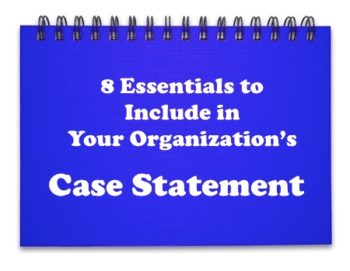Are your fundraising efforts standing on the firm foundation of an outstanding case statement? Of all the documents an organization uses to aid fundraising, the case statement is one of the most important.
The case statement (or case for support) is used by a nonprofit as a basis for all communication and solicitations with donors. As a primary tool for fundraising, a nonprofit’s case statement needs to be professional and accurate; a two to ten page (or more as needed) document that grabs the reader’s attention and can be presented as simply as a fact sheet or as intricately as a folder with supporting charts, photographs and budgets.
Ideally, a brilliant case statement will be donor-centric, written to donors and potential donors using reasoning and language that will resonate with the target audience.
Uses for a case statement
Every nonprofit knows how critical a case statement can be when approaching high level donors and prospects or fundraising for new programs and campaigns. But not every agency or organization realizes how important this short compelling argument is in their ongoing fundraising efforts.
Excerpts from a well written case statement and even the entire document have many varied uses in the fundraising scenario. For example:
- When talking to potential donors, a copy of a compelling case statement continues to present the case for support long after the meeting has concluded.
- A case statement can be included in a grant application as justification for the request.
- For direct mail or email campaigns, the message can mirror the case statement and in the case of direct mail, illuminate the copy that you include with the appeal letter.
- Organizations might use their case statement on their website.
- The case statement acts an informal script when phoning prospective donors; all the important points are gathered in one easily accessible document.
- A condensed version of the case statement, reduced to a page or two, can serve as hand-outs when donor prospecting.
Exceptional case statements contain a mixture of emotionally gripping stories; heart-warming, accounts of the work being done, coupled with cold, hard facts that verify the organization’s claim that it represents a force for change.
There are several fundamentals that go into a compelling case statement but there are no hard and fast rules as to the order these elements should appear. With the exception of a deeply gripping introduction, every case statement is unique and should be laid out in a manner that makes sense for your nonprofit.
Essentials for an outstanding case statement
1. The Introduction: Exceptional case statements always begin with a story. Make the reader feel emotionally invested in your nonprofit by using storytelling to establish a personal connection.
An emotional opening can captivate your audience at the very onset so use these introductory paragraphs to lead your donors and prospects into the remainder of the document. If your opening is inspiring and packs an emotional punch, you’ll grab the attention of the reader.
2. The mission and the vision: Outlining the mission statement of the organization answers the “why do we exist?” question and painting a bold and courageous vision for the nonprofit’s future leaves no doubt as to “Why should we care?”
By confidently illustrating your organization’s mission and vision for the future, you are telling the reader they should care because the mission and the vision matter.
3. The history: Summarize how it all began. From the founding of your nonprofit to the work it has accomplished so far. Include the philosophy, those key values and beliefs that drive your organization’s approach to answering the needs and providing the services of its mission.
4. Explain the work: Your donors, supporters and prospects need to know about the important work being done. What are the programs and services the nonprofit is currently involved in and what are the ongoing requirements to keep these services coming?
5. Successes and results based evidence: Here is where data and storytelling connect, in the tales of lives changes, testimonials of success, those the organization has helped.
Use charts and graphs to illustrate the numbers that back up your claims and measure the impact the nonprofit is having in its sphere of influence.
6. Money and funding: Dreams and visions all come with a monetary cost to accomplish. By telling donors why the funding is needed and what results will be achieved, you are inviting them to become participants in the vision.
The case statement shows the reader why they should be supporting your organization and answers the obvious questions. Why me? Why now? Keep in mind that people give because they want to make a difference; they want to be part of something epic.
7. Visuals: Don’t clutter your case statement with solid blocks of text. Create visual emphasis with charts, graphs or maps demonstrating growth. Use carefully curated images of your organization at work and captivating pictures of beneficiaries the nonprofit has helped.
8. Highlights: Is there anything that stands out in your nonprofit’s favor? Has the organization recently won an award? Anything else puts the nonprofit in the limelight? Recent press releases or articles, events that received public commendation, etc.
When writing your case statement, your objective is to create a vision so appealing that it generates in the reader a real desire to become part of the mission. Does your case statement do this? The case for support that inspires your readers will be a winning tool for your nonprofit.

